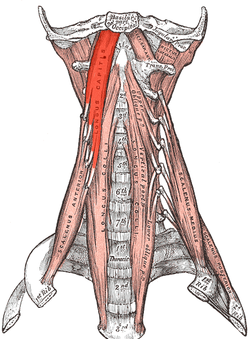| Longus capitis muscle | |
|---|---|
 The anterior vertebral muscles. | |
| Details | |
| Origin | Anterior tubercles of the transverse processes of the third, fourth, fifth, and sixth cervical vertebræ |
| Insertion | Basilar part of the occipital bone |
| Nerve | C1-C3/C4 |
| Actions | Flexion of neck at atlanto-occipital joint |
| Identifiers | |
| Latin | musculus longus capitis |
| TA98 | A04.2.01.003 |
| TA2 | 2149 |
| FMA | 46308 |
| Anatomical terms of muscle | |
The longus capitis muscle (Latin for long muscle of the head, alternatively rectus capitis anticus major) is broad and thick above, narrow below, and arises by four tendinous slips, from the anterior tubercles of the transverse processes of the third, fourth, fifth, and sixth cervical vertebræ, and ascends, converging toward its fellow of the opposite side, to be inserted into the inferior surface of the basilar part of the occipital bone.
It is innervated by a branch of cervical plexus.
Longus capitis has several actions:
acting unilaterally, to:
- flex the head and neck laterally
- rotate the head ipsilaterally
acting bilaterally:
- flex the head and neck[1]
Additional images
[edit]-
Occipital bone. Outer surface.
-
Base of skull. Inferior surface.
-
Longus capitis muscle
-
Longus capitis muscle
References
[edit]![]() This article incorporates text in the public domain from page 395 of the 20th edition of Gray's Anatomy (1918)
This article incorporates text in the public domain from page 395 of the 20th edition of Gray's Anatomy (1918)
External links
[edit]- "Anatomy diagram: 25420.000-1". Roche Lexicon - illustrated navigator. Elsevier. Archived from the original on 2015-02-26.
- PTCentral




Well, that’s interesting to know that Psilotum nudum are known as whisk ferns. Psilotum nudum is the commoner species of the two. While the P. flaccidum is a rare species and is found in the tropical islands. Both the species are usually epiphytic in habit and grow upon tree ferns. These species may also be terrestrial and grow in humus or in the crevices of the rocks.
View the detailed Guide of Psilotum nudum: Detailed Study Of Psilotum Nudum (Whisk Fern), Classification, Anatomy, Reproduction